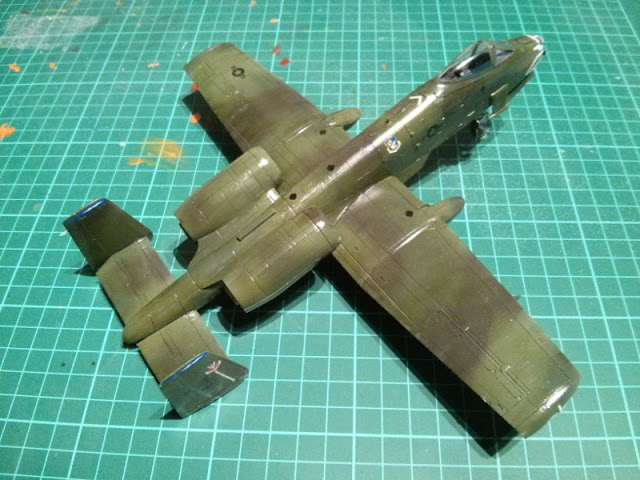Prepping
As is known, I'm not too well informed about these things and I have never bothered to get worried if a TER can carry three MOABs or not, as long as my model has had something decent installed under it. I just started painting some of the random bits I possessed based on my gut feeling. The A-10A kit's sprues contained a few different types of pylons (I assume that at least one of the types is TER) and brushpainted all quickly green (VMA 096 Panzer Olive Green).While I was at it I also painted a few bombs and four/six LAU units with the same green. In the photo below you can see a couple of lazily positioned old tv-antenna -like pylons, a couple of long-nosed bombs (GBU-10 Paweway II), a pair of GBU-8's (which I had already google-identified while working on the F-16) and a set of heretically (I assume) green-painted AGM-65s.
Some research
I thought that I'll let this weaponizing part of the project to get completely and totally out of hand. To get an idea of how to get things looking the best they could I searched the net for the colours and markings of the bombs. My first idea was to make all the Mavericks to look exactly the same, but the quote below opened up my eyes for some possibilities."When it comes to the actualy seeker head section (meaning the glass up front): Clear means it is a EO (TV or CCD) or a laser variant, and the dirty tan/yellow color means it's an IR variant." [source]
Shamefully I have to admit that I once found an awesome source for these markings, but guess if I every wrote it down, saved it anywhere or found it again? Of course not. Later on (yesterday, actually) I encountered a table that you can see in pic 2 that provided me with what I needed. Some of those I had actually remembered correctly, but having a proper cheatsheet has always been a necessity to me.
A yellow band (VMA 71002 Medium Yellow) signified a HE warhead, a brown one (VMC 70872 Chocolate Brown) a rocket motor (as far as the 'mumblings was concerned at the moment). Under these you could use whatever colour you wanted to, which suited me perfectly. The heresy I had blamed myself for earlier was not iconoclasy but an accepted approach.
Just for the fun of it I decided to make a couple of them somewhat questionable, at least if you consider the Geneva conventions. So I painted three little bombs grey (VMA 71120 USAF Medium Grey) and later I tried to apply a green (VMA 71124 USAF Green) dashed band to signify a toxic warhead.
To accompany these buggers I wanted at least a couple of napalm bombs, because why not? These'd get a red band (VMA 71085 Ferrari Red) on them, as the table above tells us. That's what I had planned on before I actually got the paintbrush in my hand...
From the plans to the workbench
Optimizing my time and all I started with the rocket motor markings of the Mavericks, because I only needed to do six of them and I didn't need brown anywhere else. Cleverly those bits had the panel lines in them for the bands (or they were intended for something else but I didn't care) in the front and back. So I painted the brown bands between the wingsets.Then I went through all the bombs from the known to the unknown ones (the GBUs 8 and 10 I had also recognized from the A2G box's instructions, of the rest I'm still blissfully ignorant) and painted a few layers of yellow on each. All this was done with a paintbrush because I was feeling way too lazy to go through with the hassle of masking tiny bands and fooling with the airbrush.
Just when I was done with that I noticed that I had done a bit too many of the yellow bands. To fix it I just painted the triplet's halves green again (see second to the last pic above). Then I glued the halves together and a bit later I painted th red bands around them. Those units just had the "I've eaten napalm" look on them.
Next to the napalm bombs you can see three small bombs with double wingsets. I painted them grey and tried to get some kind of a dashed green line painted on them. This I accomplished simply by painting a green band and then cutting it with grey length-wise strokes. I guess they'll do their jobs.
Customizing
During the earlier weeks (as a result of that aforementioned googlage) I had got an idea that I thought was awesome, would look awesome if it worked and didn't sound difficult at all to make. A subset of the Maverick missiles would have an IR seeker head, the others a laser-or EO seeker. I decided that two out of six would be the easy ones and simply painted their tips (VMC 860 Medium Fleshtone). The rest I cut off and filed off the tip that was unnecessary in my plan.Would this be worth anything? Perhaps. At leat I hoped that the result would be something more than one to entice "what have you done, you fool?" kind of comments.
















































